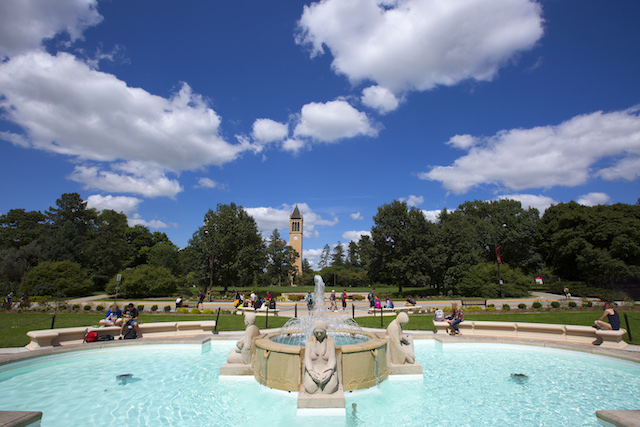
The Fountain Plaza at Iowa State University featuring Christian Petersen’s “Fountain of the Four Seasons” is an icon of the ISU campus. Photo by Chris Gannon, courtesy of Iowa State University Museums
Nov/Dec 2022 (Volume 14, Issue 6)
By Jerome Thompson
Since its installation and dedication during VEISHA in 1941, Danish-born American sculptor Christian Petersen’s “Fountain of the Four Seasons” has become an icon of the Iowa State University campus. Hundreds of thousands of students have walked by, cast pennies into the fountain, dangled feet in the waters, or casting in soap to make the waters foam. The latter is a bad idea. Most of those students take this icon for granted and are unaware of its story and how, even today, it can be a focal point of social discussion. This is the story of its creation and Petersen’s experiences and relationships that may have influenced his design.
Edgar Ruby Harlan was the second curator of the Iowa Historical Department and served in that position from 1909 until 1937. In 1929 Petersen had his studio in Chicago, Ill., when he was approached by Harlan to sculpt a portrait bust of Harlan, one of Young Bear and a bas-relief of Young Bear’s father, Pushetonequa. Pushetonequa was the last traditionally installed leader of the Meskwaki tribe, officially known by the United States government as the Sac and Fox of the Mississippi in Iowa. The Meskwaki are the only resident tribe in Iowa and live on nearly 2,000 acres of tribally owned land near Tama. They have lived at this settlement since purchasing 80 acres in 1856. Another commission by Harlan was a portrait of Henry C. Wallace, the founder of Wallace’s Farmer and secretary of agriculture under Warren G. Harding in 1926.
According to art historian, Lea Rossen Delong, Harlan became a patron to Petersen when he was struggling financially after a divorce and had moved to Chicago. Harlan made connections with influential people in Des Moines that resulted in more commissions for Petersen. These included a bronze bust of Gov. George W. Clark plus a bronze plaque of Clark. A significant commission in 1933 was the creation of a series of bronze plaques of the founders of the Equitable of Iowa Company including Benjamin F. Allen, Phineas Casaday, James Cummins, Frederick Cooper Hubbell, Frederick Marion Hubbell, Frederick Windsor Hubbell, Cyrus Kirk, Henry Nollen and Simon Cassady. These led to more commissions from Des Moines and Iowa notables.
A pivotal connection for Petersen was made in the summer of 1933 when he held an exhibition at the Younker’s Department Store Tea Room in Des Moines. This event may have led to a contact for Petersen by Raymond Hughes, president of Iowa State College in October 1933. Hughes wanted him to design a fountain for campus and offered to quarter him at his residence, known as “The Knoll,” plus pay him $100 per month while he worked on the design.
Hughes’ vision of a fountain for the Dairy Industry Building received a boost in late 1933 when an appropriation from the federal Civil Works Administration was made to create the Public Works of Art Project that would employ promising artists who were down on their luck. There were two such artists who were brought together by this project in Iowa; Grant Wood and Christian Petersen. Hughes would attract both to Ames and two of Hughes’ projects; the Grant Wood library mural, “When Tillage Begins Other Arts Follows” and Petersen’s fountain and sculpture.
In Petersen’s case Hughes required that the bas relief sculpture be made on campus and utilize the Ceramic Engineering department that specialized in terra cotta. In this way Hughes was able to bring a sculptor to campus, establishing the first artist in residence and began an art on campus program that continues to thrive today.
TO READ THE ENTIRE STORY AND OTHER FASCINATING STORIES ABOUT IOWA HISTORY, subscribe to Iowa History Journal.
